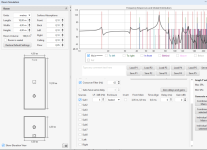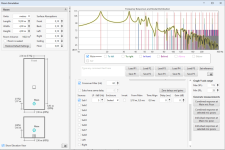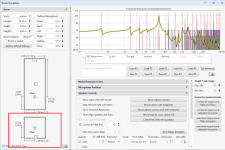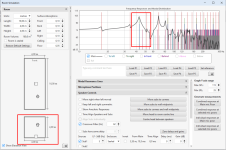Here is a trick Kimmosto has posted about few times:
using REW room simulator, input 10x dimensions, 0.1x frequency to emulate a speaker.
Using a sub as the driver within box, listener is about at port inlet and the graph shows noise at that position with the sub position. There is no damping here and so on, but the underlying physics is same with room modes or box modes so this is indication between better and worse situation that considers only position of the driver and port inlet.
Here the source is midway to minimize lowest mode, and port inlet adjusted for minimal peaks above.

Moving both a little leads to much more noisy situation, difference on pass band could be tens of dB:

On the above, 17Hz peak on 10m long room means 170Hz peak on 1m tall speaker, it's 10x scaled situation.
Perhaps it goes unnoticed, there is often quite a dip around low mids anyway, due to early reflections making a deep null there, so perhaps positioning can get rid of some box noise as well.
using REW room simulator, input 10x dimensions, 0.1x frequency to emulate a speaker.
Using a sub as the driver within box, listener is about at port inlet and the graph shows noise at that position with the sub position. There is no damping here and so on, but the underlying physics is same with room modes or box modes so this is indication between better and worse situation that considers only position of the driver and port inlet.
Here the source is midway to minimize lowest mode, and port inlet adjusted for minimal peaks above.

Moving both a little leads to much more noisy situation, difference on pass band could be tens of dB:

On the above, 17Hz peak on 10m long room means 170Hz peak on 1m tall speaker, it's 10x scaled situation.
Perhaps it goes unnoticed, there is often quite a dip around low mids anyway, due to early reflections making a deep null there, so perhaps positioning can get rid of some box noise as well.
Last edited:
Thanks for these insights! I have REW but have never attempting anything like that.
I note that ATC puts their ports immediately below the woofer and to one side, aligned with the mid/tweeter.

Would something like this be a safer/better position?
I note that ATC puts their ports immediately below the woofer and to one side, aligned with the mid/tweeter.
Would something like this be a safer/better position?
Personally I love this look (I like the port more centered in bottom if possible, but understand your inspiration, and certainly @6L6 approves 😎). Also—the following is just my opinion—BUT—I'd avoid MDF at all costs—that is only because I HATE working with it. My "regular" sized OSMCs are already extremely heavy, I can't imagine having to lift what you are proposing. I also suspect that it's not at all necessary—I would however totally play around with what Matthias did with the layer of aluminum. I didn't do that mostly for cost reasons....Not sure any of this would be audible...BUT if I knew then what I know now—I would have done it since any improvement on awesome is just more awesome since I can say there is zero risk in building these speakers. And, do you have the Volts in hand? They are at least 10-15 lbs each. Nuts!Hi, again –
As mentioned above, I have been thinking about a tower version of the OSMC. To fit into our living space, and not be larger than the current speakers, 100cm would be a good height. Keeping the width and depth of the OSMC, I sketched the following and wonder if I am missing anything or making silly mistakes? Assuming 18 mm nominal thickness for the 3/4" Baltic birch available here in the US, the volume would be about 106l.
View attachment 1266193
View attachment 1266194
The two upper braces would be identical to the OSMC ones, and a third brace (or more) could be placed below the woofer. This brace could also be the top or bottom of a small crossover compartment. Any issues with the third brace or crossover compartment?
I would love to make this front ported to not have the speakers too far into our living room. Port placement/height could be centered between the woofer and the bottom, or closer to the woofer. Any insights on port placement on the front? Port dimensions is another question.
Unless I can find Baltic birch thicker than ¾” (18mm nominal), I would likely put a layer of MDF on the back of the front/baffle to accommodate the min depth of 20 mm for the Volt752. Would it be beneficial to add an MDF ‘lining’ this to the rest of the cabinet if using 18mm Baltic birch? This would further reduce the volume and add some heft to the cabinet.
Any insights and suggestions will be greatly appreciated!
Cheers,
Soren
IMO, definitely DO use 15-ply birch. (I did use MDF for bracing). Here this is called "Russian" ply—and it's in a 5x5 sheet. This material is DENSE—there are no voids and there is one perfect side. You will not find it at the big box stores. You will have to find a more local woodshop that likely also sells hardwood lumber, they may be willing to order it for you if they don't stock it. It also comes in an extremely tasty 0.5" thick sheet—they could be bonded...I use both thicknesses regularly where quality matters.
Re: front baffle. I just went with a single thickness of multi-ply. I can't imagine a scenario where rigidity would be a factor in that decision with the side walls so close to the woofer basket, and all the bracing. To account for the 20mm depth of the Volt I cut a ring of cork/rubber matt, that's available in many thicknesses—I ended up using 3/32". Came out perfect with maybe the Volt just a hair behind the face, basically right where it should be IMO. That driver is not small, what you see on the front is deceiving. It's a bit of Jenga to fit it in place with the woofer...I mention this related to the double MDF idea, there won't be much behind that driver and your screws may be long—and getting the Volt in place and not having sloppy baffle holes and not cross-threading the Volt is a challenge. I'd say keep it simple..... and build them again later if you love them and feel the need to eek out whatever you think might be missing (nothing! Haha).. Joking... it's all personal taste (placement?), assuming some baselines where met—they were.
Hi,Thanks for these insights! I have REW but have never attempting anything like that.
I note that ATC puts their ports immediately below the woofer and to one side, aligned with the mid/tweeter.
View attachment 1266475
Would something like this be a safer/better position?
well, it could, depends where the inlet of the port is. The port could have a bend for example. It might be just visual thing, because if you try the sim the longest dimension really dominates the modes and the "height" is most important here, of course the "width" and "depth" also matter some.
The relatively random example I posted yesterday has symmetric width and depth so if the port (head) is offset on one dimension but fine on the other it's still alright, but offset both even a little and a peak appears. It's fiddly in this sense.


I encourage you to try REW, just input the room dimensions (your speaker dimensions scaled x10) and move the source and head with mouse and look the graph.
All this doesn't guarantee your port output is problem free, but I think it is a good indicator giving you a better chance if you put the port inlet to a position where SPL is lower than higher. At least try to avoid positions where you have strong modal peaks.
What you especially want to do is avoid the lowest modes, those are the most problematic as those if any are on the pass band, or closest to, and they are also least affected by damping material inside the box. Having transducer / port midway of any dimension gives most advantage on these.
Have fun!
Last edited:
This faceplate replaces the horn so would change the speaker. But I see where you are coming from. I had a mounting plate laser cut which I also used as a routing and drilling guide, made things much easier. Also, without it the screws would dig into the baffle and the driver could become somewhat loose over time.Just saw this on Solen’s website. Might make life easier for some folks.
Do not use these for the OSMC! These flate faceplates will alter the dispersion of the Volt driver, so things would be totally off in the OSMS design.Just saw this on Solen’s website. Might make life easier for some folks.
…and change the time alignment as the Volt’s voicecoil will be further forward than designed.
Thanks for the clarification! Very important indeed 😬Do not use these for the OSMC! These flate faceplates will alter the dispersion of the Volt driver, so things would be totally off in the OSMS design.
Best,
Anand.
Thanks for the props @poseidonsvoice!
@maximax77 — There may a some very very slight compression of screw heads into the finish—and certainly if you really crank on the bolts (don't)—but the baffle hole itself is holding the lions share of the weight. Mine haven't loosened at all, I have checked from time to time. The seasonal movement of plywood is negligible—We live in the NE US.
@maximax77 — There may a some very very slight compression of screw heads into the finish—and certainly if you really crank on the bolts (don't)—but the baffle hole itself is holding the lions share of the weight. Mine haven't loosened at all, I have checked from time to time. The seasonal movement of plywood is negligible—We live in the NE US.
For today's entertainment... I did a mock up last night to see how/if the OSMC would fit into our living space. Let's just say I will focus on the 'smaller', regular OSMC and not the tower version 😉 This is a sizeable speaker.

I am rereading the thread to absorb more details. I did not see it, yet, but was bottom porting considered, or is this a poor idea? I am more or less resigned to the rear port as designed.
I am rereading the thread to absorb more details. I did not see it, yet, but was bottom porting considered, or is this a poor idea? I am more or less resigned to the rear port as designed.
But get the tweeter to earheight or a kittle above somehow.
Cheers!
Cheers!
The standard OSMC will have to go on a stand and will have the same footprint as the tower. It may or may not have the same height as the tower version depending on the stand. So no big difference I’d say.Let's just say I will focus on the 'smaller', regular OSMC and not the tower version 😉 This is a sizeable speaker.
As you may have read… my wife was educated via the sweet sounds (as was I!)….the issue became moot… but I also didn’t exactly ask permission. Also, night shot just now… “Xover stands”… 33.5” total height..
And for reference of my potential WAF battle than never happened.. our previous speaks were B+W CM-1, or a very tiny bookshelf speaker…you are already 3/4 of the way there! They will look great!

And for reference of my potential WAF battle than never happened.. our previous speaks were B+W CM-1, or a very tiny bookshelf speaker…you are already 3/4 of the way there! They will look great!
That's such a beautiful build! This is a 'family' build. We both want to try something a bit more dynamic than the 87db Sonus Fabers. I will say the recently completed x252 amp made strides in that direction.
There was a lengthy discussion about this somewhere in the thread, and the (my) conclusion was that a front port is not the best idea. A front port would need to be a rather narrow/flat channel that ends at the lower rear corner of the box. The acoustics of this arrangement did not work out well. It's better if the port is wide open and can breathe somewhere near the center of the box. If you don't like the rear port for whatever reason, you could do a side port with the same dimensions as the rear port.was bottom porting considered, or is this a poor idea? I am more or less resigned to the rear port as designed.
Sure. Still, the looks of an OSMC tower version are quite different than the standard OSMC, at least to my eyes.The standard OSMC will have to go on a stand and will have the same footprint as the tower. It may or may not have the same height as the tower version depending on the stand. So no big difference I’d say.
I think this is one of the moste beautiful builds überhaupt! 👍🏻
- Home
- Loudspeakers
- Multi-Way
- Open Source Monkey Box